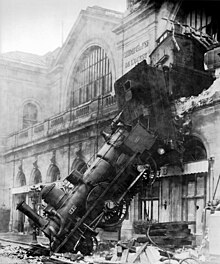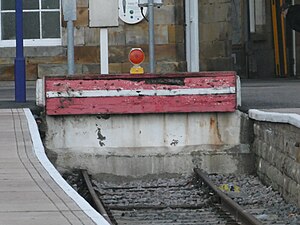Buffer stop

Abuffer stop,bumper,bumping post,bumper blockorstopblock(US), is a device to preventrailway vehiclesfrom going past the end of a physical section oftrack.
The design of the buffer stop is dependent, in part, on the kind of couplings that the railway uses, since thecoupling gearis the first part of the vehicle that the buffer stop touches. The term "buffer stop" is of British origin, since railways inGreat Britainprincipally usebuffer-and-screw couplingsbetween vehicles.
Types
[edit]Several different types of buffer stop have been developed. They differ depending on the type of coupler used and on the intended application.
- Buffer stops withanticlimbers.These are particularly important for passenger railway applications, because the anticlimbers reduce the likelihood oftelescopingof therailroad carsduring a head-on impact.
- Buffer stops for aknuckle coupleror anSA3 coupler(centrally positioned between the two rails)
- Buffer stops with traditional "buffers"on either side
- Hydraulic buffer stops
- Friction buffer stops (bolted down to the rail)
If there is extra room behind the bumper block, there is usually a sand or ballast drag that is designed to further retard a runaway train. One such accident occurred when a Northern City Line train powered past the bumper block atMoorgate station in 1975on theLondon Undergroundsystem.
Energy-absorbing
[edit]Largely because of its mass, a train transfers an enormous amount ofkinetic energyin a collision with a buffer stop. Rigid buffers can safely cope only with very low-speed impacts. (i.e.,nearly stationary). To improve stopping performance, a way of dissipating this energy is needed, through compression or friction. Following a buffer stop accident atFrankfurt am Mainin 1902, the Rawie company developed a large range of energy-absorbing buffer stops. Similar hydraulic buffer stops were developed byRansomes & Rapierin the UK.[citation needed]
Examples
[edit]- Raja Trains Depot in Tehran
- Stopping speed: 20 km/h (12 mph)
- Stopping distance: 20 m (66 ft).[1]
Wheel stop
[edit]Wheel stops or car stops are used to stop small numbers of light vehicles at the end of level storagetracksor to chock individualrailroad carson shallowgrades.[2][3][4][5][6]
Gallery
[edit]-
Two views of a Hayes-built bumper at theLinden Railroad Museum,Linden, Indiana.This design accommodates theAAR coupler.
-
Energy-absorbingbuffer stop inFrance
-
Bumper at the end of a newer tunnel in theToronto subwaysystem beyond a terminal station
-
Simple timber stop atScarborough
Examples of accidents
[edit]
- 22 October 1895 –Gare Montparnasse,Paris,France– An express trainoverran the buffer stop and fell into the street below.
- 1902 –Frankfurt am Main,Germany– Serious buffer stop collision inspires development of Rawie range of energy-absorbing buffer stops.
- 27 July 1903 –Glasgow, Scotland– A train arriving at the St Enoch terminal station failed to stop in time andcollided heavily with the buffer stop,sustaining severe damage. Sixteen people were killed, 13 instantaneously and 3 at a later time due to injuries received. 64 people were injured, of which 17 required hospital treatment.
- 28 February 1975 –Moorgate Underground rail crash– 43 killed, 74 injured – buffer stop collision made far worse by small size "tube" train running into larger dead-end tunnel beyond. The tunnel could accommodate full-size surface stock thus permitting the smaller train to concertina inside the tunnel.
- 13 April 1978 –Budapest,Hungary– commuter train overruns a buffer stop owing to brake failure and crashes into the station building. 16 killed, 25 injured.[7]
- 8 January 1991 –Cannon Street station rail crash,London – 2 killed, 200+ injured – commuter train hits buffer stops.
- 22 February 2012 –Buenos Aires,Argentina–a commuter train collided with buffer stopsat a train station in Buenos Aires during the morning rush hour. The accident killed 51 people and injured more than 700 in Argentina's worst rail accident in 30 years.[8]The buffer stops' hydraulic components were found to be disabled[9]and did not absorb the energy of the collision.
- 15 January 2013 –Saltsjöbaden,Sweden– A train parked with the train control lever at "Full throttle" was set in motion when a cleaner closed the door on a four-carEMUcommuter train in Neglinge depot. It reached 80 km/h and demolished a buffer stop at Saltsjöbaden station beforecrashing into a small apartment block beyond the end of the track,badly injuring the cleaning lady.[10]
- 13 August 2014 –Manila,Philippines– A southboundMRTC 3000 classtrain of theMRT Line 3lost power while departingMagallanes station,prompting a second train to be sent to push the train toTaft Avenue station.However, the unpowered train suddenly decoupled while in motion and overshot the retarding buffer at Taft Avenue station. As a result, the train derailed ontoTaft Avenue,causing multiple injuries. An investigation by theDepartment of Transportation and Communicationsshowed that standard coupling procedures were not followed and that the runaway train did not use itsautomatic brakesas it was unpowered, adding that the retarding buffer at the station was only designed to handle a maximum speed of 15 kilometers per hour (9.3 mph).[11]
- 20 March 2015 –Uttar Pradesh,India– TheDehradun-VaranasiJanata Expressderailed nearBachhrawan,resulting in at least fifty-eight deaths and 150 people being injured. The driver reported by radio that the brakes on the train had failed, and that he could not stop the train. It was diverted into a siding andcrashed through the buffers at Bachhrawan.[12]
- 29 September 2016 –Hoboken, New Jersey– Thecab carof a NJ TransitPascack Valley Linecommuter train entering Hoboken Terminaloverran the buffer blockon track five at 8:45 am. The train continued across the low-level passenger concourse connecting the platforms and slammed into a wall of the terminal building, causing serious structural damage. One person was killed and more than 100 were injured.
- 13 March 2021 –Kirkby, United Kingdom– A Class 507 electric multiple units operated by Merseyrailcollided with the buffer stop.The only injury was the driver of the train. The cause was found to be that the driver was using a mobile phone while he was driving. The distraction led him to enter the station at excessive speed. He was fired and prosecuted, pleading guilty to a charge of endangering the safety of people on the railway.
See also
[edit]References
[edit]- ^"Infrastructure (Iran)".Railway Gazette International.1/2009: 16. January 2009.
- ^"Aldon railcar wheel stops".Archived fromthe originalon 2018-08-19.Retrieved2018-08-19.
- ^"Rails Company – Wheel Stops".Archived fromthe originalon January 30, 2020.
- ^"Wheel Stops – Track Components".kimessteel.
- ^"Western Cullen Hayes Wheel and Car Stops".Archived fromthe originalon 2018-08-26.Retrieved2018-08-19.
- ^"Car Stops – The Nolan Company".nolancompany.4 February 2016.
- ^"A Csepeli Hév fekete áprilisa – 33 éve történt a tragikus HÉV baleset".Retrieved11 November2012.
- ^"Argentine train crash kills 49 people, hurts 600".Yahoo.22 February 2012.Retrieved22 February2012.
- ^"10 años de la tragedia ferroviaria de Once en Argentina".2022-02-22. Archived fromthe originalon 2022-02-22.Retrieved2024-05-24.
[las pericias] constataron [...] que los paragolpes no contaban con su sistema hidráulico en funcionamiento [...]
- ^"Stockholm train crashed into apartments 'by cleaner'".BBC News.January 15, 2013.
- ^Camus, Miguel (August 19, 2014)."DOTC: Human error blamed for MRT-3 train accident; 4 train workers face raps".Philippine Daily Inquirer.RetrievedDecember 17,2022.
- ^Mahesh, Niha."32 Die as Train Derails Near Rae Bareli in Uttar Pradesh, 50 People Injured".NDTV India.Retrieved20 March2015.





